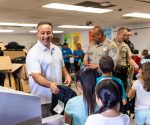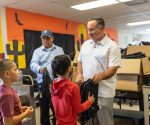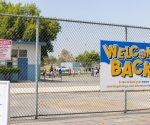By Mass Communication Specialist 1st Class Jerry Jimenez, Navy Office of Community Outreach
GREAT LAKES, Ill. – Sailors are some of the most highly-trained people on the planet, according to Navy officials, and this training requires highly-dedicated recruit division commanders.
At Recruit Training Command (RTC), otherwise known as “boot camp,” hard-charging Navy professionals, who guide recruits in the transformation process, from civilians, into disciplined, qualified U.S Navy sailors.
Petty Officer 1st Class David Garcia, a 2003 Cajon High School graduate and native of San Bernardino, California, is a recruit division commander (RDC) at RTC, who trains and mentors the future of the fleet.
“I joined because I wanted to go to college and travel the world,” said Garcia. “I wanted to be the first in the family to serve our country.”
RDCs are highly-qualified, fleet sailors, specially selected for their leadership and teaching abilities to mold tomorrow’s sailors. They must represent and teach Navy tradition, customs and discipline and be intimately familiar with instructional techniques, principles of leadership and administrative procedures.
In order to become an RDC, they must pass a highly rigorous, 13-week course of instruction, which takes place at RTC.
According to Garcia, the values required to succeed in the Navy are similar to those found in San Bernardino.
“Growing up I learned to make sure you surround yourself with positive people, so you can have positive impacts in your life,” said Garcia.
In 1994, RTC Great Lakes became the Navy’s only recruit training facility. The mission of RTC is to transform civilians into smartly disciplined, physically fit, basically trained Sailors who are ready for follow-on training and service to the fleet while instilling in them the highest standards of Honor, Courage, and Commitment.
Recruit training involves a change in the mental and physical capacity of the new recruit, according Navy officials. From the first day at RTC through graduation day when new sailors board the bus to depart, recruits find themselves in a whirl of activity. Every recruit entering the Navy today will remember RTC as their introduction to Navy life.
Boot camp is approximately eight weeks and all enlistees into the U.S. Navy begin their careers at the command. Their basic training curriculum is comprised of five core competencies: firefighting & damage control, seamanship, watch standing, and physical fitness. Through a hands-on learning approach, recruits ‘train how they fight’ and receive critical warfighting skills during the sailor development process. The command consists of more than 1,100 staff members, with an average of 6,000 recruits in training at any time.
With more than 90 percent of all trade traveling by sea, and 95 percent of the world’s international phone and internet traffic carried through fiber optic cables lying on the ocean floor, Navy officials continue to emphasize that the prosperity and security of the United States is directly linked to a strong and ready Navy.
According to Chief of Naval Operations Adm. Mike Gilday, four priorities will focus efforts on sailors, readiness, capabilities, and capacity.
“For 245 years, in both calm and rough waters, our Navy has stood the watch to protect the homeland, preserve freedom of the seas, and defend our way of life,” said Gilday. “The decisions and investments we make this decade will set the maritime balance of power for the rest of this century. We can accept nothing less than success.”
Serving in the Navy means Garcia is part of a team that is taking on new importance in America’s focus on rebuilding military readiness, strengthening alliances and reforming business practices in support of the National Defense Strategy.
“The Navy is important to national defense because our job is to protect the seas and prevent attacks on our nation,” said Garcia.
Garcia and the sailors they serve with have many opportunities to achieve accomplishments during their military service.
As Garcia and other sailors continue to train and perform missions, they take pride in serving their country in the United States Navy.
“Serving in the Navy means serving my country with honor, courage and commitment,” added Garcia.
 Westside Story Newspaper – Online The News of The Empire – Sharing the Quest for Excellence
Westside Story Newspaper – Online The News of The Empire – Sharing the Quest for Excellence



